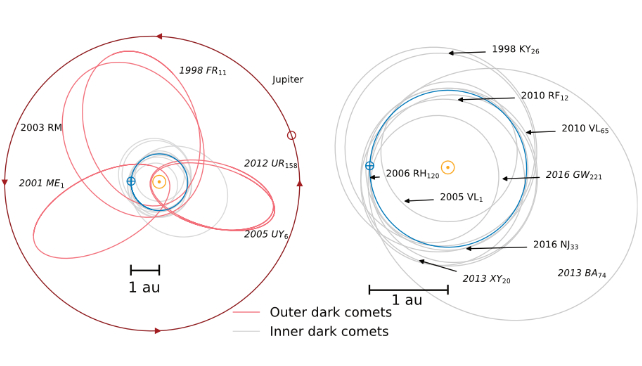Products You May Like
So often when we think we understand something, another thing comes along that forces us to pause, reconsider, and broaden our minds to encompass these new and fascinating pieces of information.
Take, for example, space rocks. We thought we had them all neatly categorized. Comets are chunks of rock filled with ices that sublimate when they warm, spewing long tails of gasses into space. Asteroids are less-icy chunks of rock and metal that just hang out being less-icy chunks of rock and metal.
Sounds pretty straightforward, right? Well, then scientists had to go and discover dark comets; comets that look like an asteroid, but behave like a comet.
The identity of these objects was unveiled in 2023, with first one dark comet, and then six more. Now, an international team of astronomers has unmasked another seven, doubling the number and bringing the total known to 14.
This new data reveals that not even all dark comets are the same: there are at least two different kinds.

And, in turn, the discovery of multiple kinds of dark comets could tell us more about how Earth was made habitable for life.
“We report detections of seven dark comets which demonstrate that there are two distinct populations based on their orbits and sizes,” writes a team of researchers led by astrophysicist Darryl Seligman of Michigan State University.
“These objects represent a class of Solar System objects that may have delivered material to the Earth necessary for the development of life such as volatiles and organics.”
One effect of cometary outgassing is that it changes the comet’s motion. Actually, there are a number of mechanisms that can accelerate a space rock. There’s orbital acceleration that can change as the rock’s proximity to the Sun changes. There’s the Yarkovsky effect, too – a change in rotation produced by contrasts in light and temperature.
Because dark comets don’t have tails that we can detect, the smoking gun that there’s more going on than in the normal asteroid is acceleration.
“When you see that kind of perturbation on a celestial object, it usually means it’s a comet, with volatile material outgassing from its surface giving it a little thrust,” says astronomer Davide Farnocchia of NASA’s Jet Propulsion Laboratory.
frameborder=”0″ allow=”accelerometer; autoplay; clipboard-write; encrypted-media; gyroscope; picture-in-picture; web-share” referrerpolicy=”strict-origin-when-cross-origin” allowfullscreen>
Although we can’t see what these dark comets are outgassing, their acceleration cannot be explained by gravity or Yarkovsky.
What we do have, now, is a sufficient quantity of dark comets to try and draw some statistical inferences.
“We had a big enough number of dark comets that we could begin asking if there was anything that would differentiate them,” Seligman says. “By analyzing the reflectivity and the orbits, we found that our Solar System contains two different types of dark comets.”
One kind inhabits the inner Solar System, inside the orbit of Mars. They tend to be on the smaller side, below around a few tens of meters, and their orbits around the Sun are quite circular and neat.

The other kind is a bit more chaotic. Their orbits are highly elliptical, travelling out nearly as far as Jupiter, and closer to the Sun than Mercury. They are also larger than the inner dark comets, reaching sizes up to hundreds of meters across.
There’s still a lot we don’t know about these enigmatic rocks. Do they contain ice, or are they releasing something else that causes them to accelerate oddly? Why are there two different populations? And how many are there?
A recent paper found that there could be way more dark comets than we know hanging out in the inner Solar System, which has implications for Earth defense since we rely on accurate orbital modeling to calculate whether an asteroid constitutes a threat. Since anomalous acceleration can alter a space rock’s orbit, we’d need to factor that information into determining if a rock was potentially hazardous.
 An illustration of interstellar object ‘Oumuamua, whose strange acceleration may be similar to that of dark comets. (NASA)
An illustration of interstellar object ‘Oumuamua, whose strange acceleration may be similar to that of dark comets. (NASA)
But the discovery of these weirdo rocks is very new, and the volume of what we don’t know about them is far larger than what we do. Figuring out what they are, where they come from, and how numerous they are is undoubtedly going to be the subject of future work.
Especially since they have implications for our own existence.
“Dark comets are a new potential source for having delivered the materials to Earth that were necessary for the development of life,” Seligman says. “The more we can learn about them, the better we can understand their role in our planet’s origin.”
The research has been published in the Proceedings of the National Academy of Sciences.
